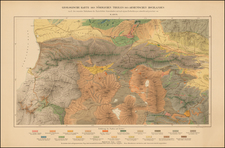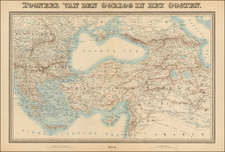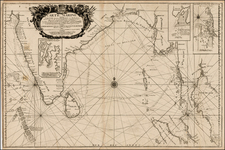Family tree of the descendants of Ghengis Khan, with a map showing the Tartar Empire.
This fascinating work provides an enlightening exploration of the extensive lineage of the Tartar Emperors descending from the famed Genghis Khan. Rooted in a profound historical context, this detailed genealogical chart casts a spotlight on the oft-misunderstood realm of Tartary, elucidating its boundaries, history, and the impact of its nomadic inhabitants on neighboring regions.
The vast expanse of Tartary, despite being long shrouded in obscurity to both geographers and chronologists, is vividly delineated in this material, drawing heavily from the meticulous efforts of Mr. Withen. His endeavor to present an authentic representation of Tartary has been faithfully replicated in this chart. It takes into account both natural boundaries and notable man-made barriers like the renowned 400-league wall separating Tartary from China. Though this wall was constructed as a formidable barrier, it did little to deter the Tartars from invading and overpowering the Chinese, as they notably did in 1645.
Central Tartary was home to various nomadic tribes, living not in permanent structures but migrating freely across the plains, dwelling in tents or moving aboard their unique chariots. These nomadic communities were organized into groups known as "Hordes". Furthermore, the Tartary region encapsulated multiple kingdoms. Intriguingly, it is believed that the art of printing was discovered over a millennium ago in the Tangut Kingdom within Tartary.
While the exact timeline remains elusive regarding when the Tartars dominated the territories between the Janais and Boristhene, now referred to as Petite Tartary, their skirmishes and conquests in China are more clearly documented. Historical records suggest that the Tartars' warfare against China commenced around 2341 years before the common era. By 1280, the Tartars, under a lineage known as Iven, overran China, reigning for approximately 89 years. However, by 1369, the Tartars were expelled, making way for sovereign rulers of the Mim dynasty. Notably, in 1645, under the leadership of King Kunchi, also called the Grand Can, the Tartars invaded China again, marking the beginning of a new reign by this Tartar prince's descendants.
This genealogical chart, with its rich detailing and historical annotations, unveils the intertwined destinies of the Tartars and their neighboring empires. Through its pages, the profound influence of the Tartar lineage, especially as descendants of the legendary Genghis Khan, on the geo-political landscapes of Asia, is irrefutably evident.
Henri Abraham Chatelain (1684-1743) was a Huguenot pastor of Parisian origins. Chatelain proved a successful businessman, creating lucrative networks in London, The Hague, and then Amsterdam. He is most well known for the Atlas Historique, published in seven volumes between 1705 and 1720. This encyclopedic work was devoted to the history and genealogy of the continents, discussing such topics as geography, cosmography, topography, heraldry, and ethnography. Published thanks to a partnership between Henri, his father, Zacharie, and his younger brother, also Zacharie, the text was contributed to by Nicolas Gueudeville, a French geographer. The maps were by Henri, largely after the work of Guillaume Delisle, and they offered the general reader a window into the emerging world of the eighteenth century.










![Northern Hindostan [with] Nepaul [with] Cabul](https://storage.googleapis.com/raremaps/img/small/62805.jpg)



![[ Black Sea ] The Euxine or Black Sea From The Russian Survey of 1826](https://storage.googleapis.com/raremaps/img/small/99954.jpg)